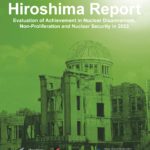Hiroshima Report 2018(3) IAEA SAFEGUARDS APPLIED TO NWS AND NON-PARTIES TO THE NPT
A NWS is not required to conclude a CSA with the IAEA under the NPT. However, to alleviate the critic isms about the discriminatory nature of the NPT, the NWS have voluntarily agreed to apply safeguards to some of their nuclear facilities and fissile material that are not involved in military activities. All NWS have also concluded tailored Additional Protocols with the IAEA.
The IAEA Annual Report 2016 (Annex) published in September 2017 lists facilities in NWS under Agency safeguards or containing safeguarded nuclear material.38 For these five NWS, the IAEA “concluded that nuclear material to which safeguards were applied in selected facilities remained in peaceful activities or had been withdrawn from safeguards as provided for in the agreements.”39 The IAEA does not publish the number of inspections conducted in the NWS. The safeguarded facilities include:
- China: A power reactor, a research reactor, and an enrichment plant
- France: A fuel fabrication plant, a reprocessing plant, and an enrichment plant
- Russia: A separate storage facility
- The United Kingdom: An enrichment plant and two separate storage facilities
- The United States: A separate storage facility
Each NWS has already concluded an IAEA Additional Protocol. Among them, the respective Protocols by France, the United Kingdom and the United States stipulate that the IAEA can conduct complementary access. Among them, the United States is the only country that has hosted a complementary access visit by the IAEA. Compared to the three NWS mentioned above, application of IAEA safeguards to nuclear facilities by China and Russia are more limited. No provision for complementary access visits is stipulated in their Additional Protocols.
France and the United Kingdom respectively have offered to make certain civil nuclear material subject to IAEA safeguards under trilateral agreements with EURATOM and the IAEA. However, because of the prospective withdrawal of the United Kingdom from the European Union (EU), or “Brexit”, the United Kingdom will withdraw from the EURATOM. In October 2017, a Nuclear Safeguards Bill was introduced to UK parliament, whose purpose is to establish a system of domestic safeguards to replace the existing EURATOM safeguards when the United Kingdom will withdraw from it in 2019.40 The United Kingdom stated at the IAEA General Conference: “the UK is establishing a domestic nuclear safeguards regime which will deliver to existing Euratom standards. This will ensure that the IAEA retains its right to inspect all civil nuclear facilities, and will continue to receive all current safeguards reporting, ensuring that international verification of our safeguards activity continues to be robust.”41
Between 1996 and 2002, Russia, the United States and the IAEA undertook to investigate technical, legal and financial issues associated with IAEA verification of fissile material derived from dismantled nuclear warheads. However, such material has not yet been under the IAEA verification.
India, Israel and Pakistan have concluded facility specific safeguards agreements based on INFCIRC/66. These non-NPT states have accepted IAEA inspections of the facilities that they declare as subject to these agreements. In this regard, Pakistan and the IAEA brought into force a safeguards agreement based on INFCIRC/66, under which two nuclear reactors provided by Pakistan are subject to the IAEA safeguards. According to the IAEA Annual Report 2016, the facilities placed under IAEA safeguards or containing safeguarded nuclear material in non-NPT states as of December 31, 2016 are as follows:42
- India: Seven power reactors, two fuel fabrication plants, two reprocessing plant, and a separate storage facility
- Israel: A research reactor
- Pakistan: Five power reactors and two research reactors
Regarding their activities in 2016, the IAEA “concluded that the nuclear material, facilities or other items to which safeguards were applied remained in peaceful activities.”43
Concerning the protocols additional to non-NPT states’ safeguards agreements (which differ significantly from the model Additional Protocol), the Indian-IAEA Additional Protocol entered into force on July 25, 2014. This Additional Protocol is similar to ones that the IAEA concluded with China and Russia, with provisions on providing information and protecting classified information but no provision on complementary access. No negotiation has yet begun for similar protocols with Israel or Pakistan.
Some NNWS call on the NWS for further application of the IAEA safeguards to their nuclear facilities in order to alleviate a discriminative nature that NNWS are obliged to accept full scope safeguards to their respective nuclear activities while NWS do not need to do so. The NAM countries, in particular, continue to demand that the NWS and non-NPT states should accept full-scope safeguards.44
[38] IAEA Annual Report 2016, GC(61)/3/Annex, September 2017, Table A32(a). The IAEA does not declassify the number of inspections that the IAEA conducted in each NWS, respectively.
[39] IAEA Annual Report 2016, September 2017, p. 96.
[40] “Nuclear Safeguards Bill Introduced Today,” Press Release, Gov.UK, October 11, 2017, https://www.gov.uk/government/news/nuclear-safeguards-bill-introduced-today. The proposed bill is posted on the U.K. Parliament homepage (https://services.parliament.uk/bills/2017-19/nuclearsafeguards.html).
[41] “Statement by the United Kingdom,” IAEA General Conference, September 18-22, 2017, https://www.iaea.org/sites/
default/files/gc61-uk-statement.pdf.
[42] IAEA Annual Report 2016, GC(61)/3/Annex, September 2017, Table A32(a). The IAEA does not declassify the
number of inspections that the IAEA conducted in each country, respectively.
[43] IAEA, IAEA Annual Report 2016, September 2017, p. 92.
[44] NPT/CONF.2020/PC.I/WP.21, April 20, 2017.






